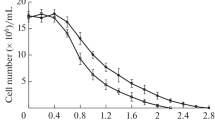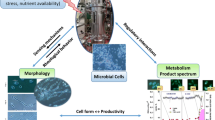Abstract
Yeast cells exposed to adverse conditions employ a number of defense mechanisms in order to respond effectively to the stress effects of reactive oxygen species. In this work, the cellular response of Yarrowia lipolytica and Pichia pastoris to the exposure to the ROS-inducing agents’ paraquat, hydrogen peroxide, and increased air pressure was analyzed. Yeast cells at exponential phase were exposed for 3 h to 1 mM paraquat, to 50 mM H2O2, or to increased air pressure of 3 or 5 bar. For both strains, the cellular viability loss and lipid peroxidation was lower for the cells exposed to increased air pressure than for those exposed to chemical oxidants. The glutathione induction occurred only in Y. lipolytica strain and reached the highest level as a response to PQ exposure. In general, antioxidant enzymes were more expressed in Y. lipolytica than in P. pastoris. The enzyme superoxide dismutase was induced in both strains under all the oxidant conditions but was dependent on the cellular growth phase, being undetectable in non-growing cells, whereas glutathione reductase was more induced in those conditions. Hydrogen peroxide was the most efficient inducer of catalase. Both yeast cultures underwent no cellular growth inhibition with increased air pressure, indicating that these yeast species were able to adapt to the oxidative stressful environment.






Similar content being viewed by others
References
Esterbauer, H., Schaur, R. J., & Zollner, H. (1991). Free Radical Biology & Medicine, 11, 81–128.
Giller, G., & Sigler, K. (1995). Folia Microbiologica, 40(2), 131–152.
Joaquim, A. F. V., Francisco, P. M., Ludovina, L., & Madeira, M. C. V. (2001). Journal of Biochemical and Molecular Toxicology, 15, 322–330.
1122Davies, J. M. S., Lowry, C. V., & Davies, K. J. A. (1995). Archives of Biochemistry and Biophysics, 317, 1–6.
Belo, I., Pinheiro, R., & Mota, M. (2005). Journal of Biotechnology, 115, 397–404.
Lopes, M., Gomes, N., Mota, M., & Belo, I. (2009). Applied Biochemistry and Biotechnology, 159(1), 46–53.
Pinheiro, R., Belo, I., & Mota, M. (2003). Letters in Applied Microbiology, 37, 438–442.
Coelho, M. A. Z., Amaral, P. F. F., & Belo, I. (2010). Applied Biochemistry and Biotechnology, 930-944.
Zhang, J.-h., Wu, D., Chen, J., & Wu, J. (2011). Biotechnology and Bioprocess Engineering, 16, 1196–1200.
Wang, K., Li, G., Yu, S. Q., Zhang, C. T., & Liu, Y. H. (2010). Applied Microbiology and Biotechnology, 88, 155–165.
Oliveira, C., Felix, W., Moreira, R. A., Teixeira, J. A., & Domingues, L. (2008). Protein Expression and Purification, 60, 188–193.
Potvin, G., Ahmad, A., & Zhang, Z. (2012). Biochemical Engineering Journal, 64, 91–105.
Jones, R.-P. (1987). Process Biochemistry, 118-128.
Pinheiro, R., Belo, I., & Mota, M. (2000). Enzyme and Microbial Technology, 26, 756–762.
Beers, R. F., & Sizer, I. W. (1952). Journal of Biological Chemistry, 195, 276–287.
Marklund, S., & Marklund, G. (1974). European Journal of Biochemistry, 47, 469–474.
Smith, I., Viertheller, T., & Thorne, C. (1988). Analytical Biochemistry, 175, 408–413.
Espindola, A. S., Gomes, D. S., Panek, A. D., & Eleutherio, E. A. (2003). Cryobiology, 47, 236–241.
Jamnik, P., & Raspor, P. (2003). Journal of Biochemistry and Molecular Biology, 17(6), 316–323.
Hassan, H. M., & Fridovich, I. (1978). Journal of Biological Chemistry, 253(22), 8143–8148.
Pinheiro, R., Belo, I., & Mota, M. (2002). Applied Microbiology and Biotechnology, 58, 842–847.
Ghazi-Khansari, M., Mohammadi-bardbori, A., & Hosseini, M. J. (2006). Annals of the New York Academy of Sciences, 1090, 98–107.
Grant, C. M., MacIver, F. H., & Dawes, I. W. (1996). Current Genetics, 29, 511–515.
Izawa, S., Inoue, Y., & Kimura, A. (1995). FEBS Letters, 368, 73–76.
Pigeolet, E., Corbisier, P., Houbion, A., Lambert, D., Michiels, C., Raes, M., et al. (1990). Mechanisms of Ageing and Development, 51, 283–297.
Lushchak, V., Semchyshyn, H., Lushchak, O., & Mandryk, S. (2005). Biochemical and Biophysical Research Communications, 338, 1739–1744.
Abbeg, M. A., Alabarse, P. V. G., Casanova, A., Hoscheid, J., Salomon, T. B., Hackenhaar, F. S., et al. (2010). Mycopathologia, 170, 11–20.
Biryukova, E. N., Medentsev, A. G., Arinbasarova, A. Y., & Akimenko, V. K. (2006). Microbiology, 75(3), 243–247.
Braconi, D., Possenti, S., Laschi, M., Geminiani, M., Lusini, P., Bernardini, G., et al. (2008). Journal of Agricultural and Food Chemistry, 56, 3836–3845.
Lushchak, V. I. (2011). Comparative Biochemistry and Physiology. C, 153, 175–190.
Semchyshyn, H. M., & Lozinska, L. M. (2012). FEMS Yeast Research, 12, 761–773.
González-Párraga, P., Hernández, J. A., & Argüelles, J. C. (2003). Yeast, 20, 1161–1169.
Kreiner, M., Harvey, L. M., & McNeil, B. (2002). Enzyme and Microbial Technology, 30, 346–353.
Bayliak, M. M., Semchyshyn, H. M., & Lushchak, V. I. (2006). Biochemistry (Moscow), 71, 1013–1020.
Acknowledgments
The authors acknowledge the financial support provided by “Fundação para a Ciência e Tecnologia” (Grant SFRH/BD/47371/2008).
Author information
Authors and Affiliations
Corresponding author
Rights and permissions
About this article
Cite this article
Lopes, M., Mota, M. & Belo, I. Comparison of Yarrowia lipolytica and Pichia pastoris Cellular Response to Different Agents of Oxidative Stress. Appl Biochem Biotechnol 170, 448–458 (2013). https://doi.org/10.1007/s12010-013-0205-3
Received:
Accepted:
Published:
Issue Date:
DOI: https://doi.org/10.1007/s12010-013-0205-3




